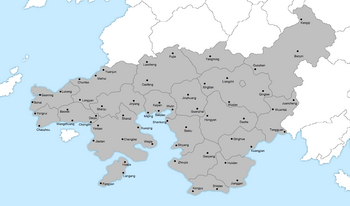Socialist Republic of Shangea
Socialist Republic of Shangea 晓东社會主義共和國 Xiǎodōng shèhuì zhǔyì gònghéguó | |||||||||||
|---|---|---|---|---|---|---|---|---|---|---|---|
| 1940–1960 | |||||||||||
| Motto: 全世界無產階級和被壓迫的民族聯合起來! Quánshìjiè wúchǎnjiējí hé bèi yāpò de mínzú liánhé qǐlai! | |||||||||||
| Anthem: 英特纳雄耐尔 L'Internationale | |||||||||||
 | |||||||||||
| Capital | Rongzhuo | ||||||||||
| Common languages | Shangean | ||||||||||
| Government | Unitary socialist council republic | ||||||||||
| Grand Marshal | |||||||||||
• 1940-1947 | Lu Keqian | ||||||||||
| State Chairman | |||||||||||
• 1940-1947 | Wu Jinmo | ||||||||||
• 1947-1960 | Ma Renzhong | ||||||||||
| Legislature | Shangean People's Political Consultative Congress | ||||||||||
| History | |||||||||||
| 14th April 1935 - 10th January 1940 | |||||||||||
• 1960 Shangean coup d'état | 31st March 1960 | ||||||||||
| Currency | Kuai | ||||||||||
| |||||||||||
The Socialist Republic of Shangea (Shangean: 晓东社會主義共和國; Xiǎodōng shèhuì zhǔyì gònghéguó) was a sovereign state based in Shangea from the victory of the Shangean Revolutionary Army in the Shangean Civil War in 1940 to the 1960 Shangean coup d'état by National Principlist officers. It was the second Coian council republic after Dezevau and the worlds largest both by population and area throughout its existence.
After the conclusion of the Shangean Civil War in 1940 that had resulted in the defeat of the Grand Alliance-backed Wulin government the revolutionary forces under the direction of Lu Keqian concluded the so-called "fusion" of neosocialist National Principlism and Nemstovite council communism. The resulting socialist republic thus constituted a united front of both the revisionist national-socialists and the orthodox communists with a significant degree of centralisation despite the lack of a single-party state. The regime rather enforced balance between the Xiaodong Regeneration Society and the Shangean Section of the Workers' International.
The Socialist Republic coincided with the period of Shangean reconstruction from the Great War and resulting civil war. During its existence it managed a centrally planned command economy with nationalisation of industry and the largest land reform in human history. Despite focusing on heavy industry industrial development only barely surpassed its pre-war output under the Socialist Republic with the economy remaining primarily agricultural.
In foreign policy the Socialist Republic became known for its stringent support for anti-imperialism often supporting its erstwhile rival Senria in this endeavour particularly after the Solarian War. Détente between Senria and Shangea under the direction of Chen Xuechang and Tokiyasu Kitamura lead to the end of the Senrian occupation of the Kaoming peninsula, the recognition of Nakong and the beginning of Senrian-Shangean economic cooperation. The Socialist Republic largely supported the Red Surge and the Association of Emerging Socialist Economies.
By the late 1950s a declining economy had caused unrest particularly after the government implemented a failed collectivisation campaign that caused a rural unrest in eastern Shangea. The cross-strait détente policy had also angered hardliners in particular the freezing of nuclear development. The governments slow response to the Great Zhongnan earthquake in 1960 would directly trigger the 1960 coup when hardline National Principlist overthrew the government. The Socialist Republic would be replaced by the modern-day Auspicious Republic of Shangea governed on National Principlist grounds shortly after beginning the Rejuvenation period in modern Shangean history.

